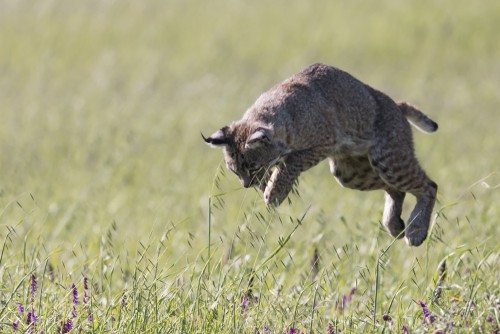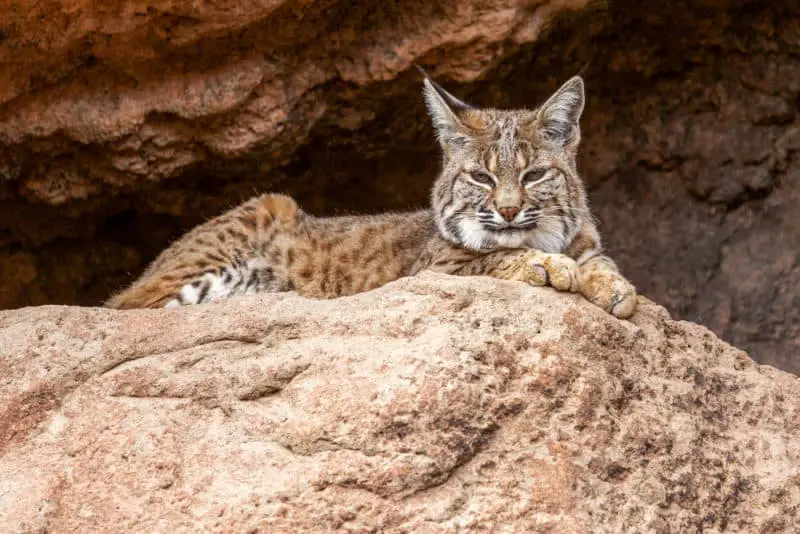Although both bobcats and mountain lions are native to Rhode Island, today, the only existing wild cat species within the state is the bobcat.
While mountain lions are native to Rhode Island, as well as all of New England, according to the Rhode Island Department of Environmental Management Division of Fish and Wildlife, they are extirpated from the state.

Bobcats in Rhode Island (Lynx rufus)
The bobcat, which is also known as the red lynx, the bay lynx, or the swamp tiger, is a North American wild cat. Biologists believe that both the bobcat and the Canada lynx are descendants of the Eurasian lynx whose ancestors crossed into North America via the Bearing Sea land bridge.
What do bobcats look like?
Adult bobcats are similar to their close relative, the Canadian lynx, in appearance, with some differences. An Adult bobcat is slightly smaller than an adult Canada lynx.
Compared to Canadian lynx, which thrive in deep snow country, bobcats struggle more in the snow due to the fact that they cannot walk on top of it as lynx can. A lynx’s large paws function like snowshoes keeping it on the snow’s surface. They have evolved this characteristic to hunt snowshoe hares in the winter. On the other hand, compared to lynx, bobcats have small feet that tend to sink into the snow. If the snow is too deep and powdery, it reduces their mobility along with their ability to catch prey.
A bobcat is roughly twice the size of a domestic house cat. They are 2 to 3 feet long and weigh 15 to 35 pounds. Adult male bobcats are around 33% larger than female bobcats.
These animals have “bobbed,” short tails with black tips and black bars on the upper surface. The black tip on their tail is only on its upper surface but not the back. As opposed to a lynx’s tail which looks like it was dipped in black paint.
Their fur is usually gray to brown, with mottled dark spots that range from black to dark brown on their bodies. “A note on this is that in the eastern U.S., bobcats have fewer spots on their bodies than bobcats in the west do.” They also have black stripes on their inner forelegs and tail.
From a side view, you will notice that a bobcat is slightly higher at the rump than at the shoulders. Bobcats and lynx have long hind legs in proportion to their forelegs.
Bobcats have black-tufted ears. In other words, they have short tufts of black hair that poke up above their ears and are black at the tips. The backs of their ears, below the black tips, are black. In the center of the black of each ear, they have a single white spot. This gives the impression of a false eye on the back of each ear.
They also have a whiskered face that seems broader due to their prominent face ruff and whiskers. Their eyes are yellow with round black pupils.
In 2020, film footage of a rare black bobcat was taken near Danville, Vermont. See. These melanistic bobcats have all the markings that non-melanistic ones do. They manifest as darker black spots on top of lighter black or dark grey.
Where do bobcats live?
Bobcats reside only in parts of North America. They’re also the most common wild cat in North America. Their range begins in southern Canada and then extends south through most of the continental United States and down into central Mexico.
In recent years, bobcat sightings in the Ocean State have been on the increase. In 2021, state officials from the Rhode Island DEM and biologists from the University of Rhode Island Wildlife Genetics and Ecology Lab completed a five-year study. To conduct this study, they trapped and tagged bobcats to monitor their movements. They also observed them on trail cameras. At the study’s conclusion, researchers believe that the bobcat population in Rhode Island is somewhere around 80 to 85 animals.
In 2022, there were reported bobcat sightings in Washington County, Providence County, Kent County, and South County.
Bobcat sightings are rare because they are mostly nocturnal or crepuscular animals. Your best chances of spotting one are in the early morning and early evening hours.
Other than their inability to cope with deep snow, bobcats are pretty versatile and tend to utilize all the different habitat types within their range. In Rhode Island, bobcats inhabit rocky ledges, hardwood forests, swamps, bogs, and brushy areas. They also exist in but are less frequently in areas adjacent to agricultural land and suburban areas. They also seem to thrive in wooded areas in close proximity to clear cuts. Studies show that small mammal populations increase in clear-cut areas. This is due to the improved food and cover conditions that a clear-cut creates. See
In urban surroundings, it’s not unheard of for a bobcat to stake out someone’s backyard bird feeder.
Sometimes people in rural or even suburban and urban residential areas have bobcats in the neighborhood, and they don’t realize it. It’s a very rare occurrence, but sometimes these animals will end up in someone’s home or garage. If you ever accidentally corner a bobcat, immediately give it some space. Back away and leave a door open for it to escape on its own. For your own and the animal’s safety, never approach a cornered bobcat. These are dangerous wild animals and will do their best to tear you up if they feel the need to defend themselves. If you have an intruding bobcat that won’t leave on its own, call on your local DEM officer and or an animal control officer to remove it for you.

What do bobcats eat?
Despite being small animals, bobcats are aggressive, tough predators. At times, particularly during the winter, they take larger animals that are quite a bit bigger than they are, such as deer. In Rhode Island, for instance, they sometimes prey on white-tailed deer.
However, their regular diets mainly consist of small mammals such as cottontail rabbits, woodchucks, squirrels, chipmunks, mice, and voles. They also feed on reptiles, birds, insects, and carrion. When they take up residence close to a residential area, their menu might occasionally also include domestic pets, small livestock, and poultry.
They even prey on venomous snakes when the opportunity arises despite not being immune to the venom. They accomplish this by using their quickness to pin the snake’s head down with a paw, after which they dispatch the snake with a quick bite to its spine behind the head.
Fortunately for the residents of Rhode Island, none of the state’s twelve species of snake are venomous.
Reproduction and Life Cycle for Eastern Bobcats in Rhode Island
In Rhode Island, mating season for bobcats varies between late February and May. Bobcats are polygamous. This means that a male bobcat may mate with multiple females.
If they successfully mate, the gestation period for bobcats is 60 days.
After breeding, the male and female go their separate ways. Other than in the exceptions of breeding and raising young, they’re solitary animals.
The female takes all responsibility for the selection of a den site and the rearing of the young.
Bobcats often use rock crevices as den sites but may also den in the cavity beneath an overturned stump or beneath a blown-down tree,
In Rhode Island, the bobcat litter size ranges from 1 to 4 kittens. The average size is 2.
Bobcat kittens are born with their eyes sealed, just like domestic cats are. However, their eyes will open when they are a week to 10 days old. By the time they are 2 months old, they will have replaced their spotted baby fur with a haircoat similar to what their parents have.
By mid-July, the kittens begin to venture out with their mothers to fine-tune their survival skills. Their training may last into the early winter. By mid-winter, the kittens strike out on their own.
Female bobcats reach sexual maturity at 1 year of age, while males reach sexual maturity at age 2.
In Rhode Island, bobcats live an average of around 12 years in the wild. See

Are there mountain lions in Rhode Island?
The presence of mountain lions in Rhode Island hasn’t been confirmed in a very long time. The big cats are native to the Ocean State, just as they are to all of New England. However, habitat loss due to human population growth and overhunting led to their extirpation in the 19th century.
Eastern mountain lions had disappeared from the entirety of the eastern United States and Canada, with the exception of southern Florida by the early twentieth century. In fact, in 2018, the U.S. Fish and Wildlife Service removed the eastern cougar from their endangered species list and declared them to be extinct.
The closest known mountain lion populations to Rhode Island are in Florida, Nebraska, and South Dakota, respectively.
In 2011, several residents of Matunuck in the Rhode Island city of South Kingstown reported seeing a mountain lion-like animal. At this time, a deer carcass that had been fed upon by a large carnivore was also located. However, the Rhode Island DEM declined to confirm these to be actual mountain lion sightings.
According to DEM wildlife biologist Charles Brown, although the Rhode Island Department of Environmental Management receives several reports of mountain lion sightings each year, they are difficult to confirm. The last confirmed mountain lion in Rhode Island was in 1847. See
It’s not completely out of the realm of possibility for a mountain lion to be present in Rhode Island. Sometimes juvenile males travel hundreds of miles from established cougar populations as they seek to claim their own territory free from dominant male mountain lions. a famous case of this occurred in 2011 when a male mountain lion traveled east from South Dakota to eventually be struck by a car and killed in Connecticut. See
Rustic Acres Wildcat Rescue
Rustic Acres Wildcat Rescue in Chepachet, Rhode Island, is a non-profit feline sanctuary. To quote from their website, “We rescue and provide forever care to unreleasable wild cats and wild cats who were illegally owned or seized would otherwise be euthanized.”
Rustic Acres Wildcat Rescue not only provides a safe haven for members of wild cat species that cannot exist in the wild, but they also house a number of domestic stray cats.
For more information on Rustic Acres Wildcat Rescue, look here.


